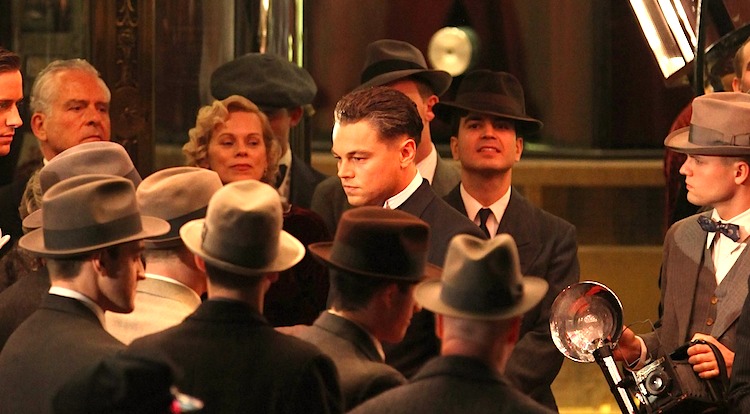
By Jason Apuzzo. • I had the opportunity recently to read Dustin Lance Black’s screenplay for the new Clint Eastwood-Leonardo DiCaprio film J. Edgar, set for release this October. Even though the film covers a fair bit of Cold War history, in terms of the FBI’s handling of communist infiltration, due to the fact that J. Edgar covers Hoover’s full professional story – from his rise in the late 1910s all the way through to the Nixon years – I’ve decided to talk about the screenplay outside the context of one of our regular Cold War Updates!. I would love to give the screenplay an even more exhaustive write-up, frankly, but due to my own time constraints I’ll have to keep things brief – and focus primarily on what the film will be saying about the anti-communist struggle.
I’ve decided to write about this screenplay publicly because it’s covering extremely important areas of history – 50+ years of it, in fact, dwelling on issues of law enforcement and privacy that still resonate with us today – and also because we’re dealing here with an actual historical figure, with a very public record. (I’ll also try to keep things here as spoiler-free as possible – with the understanding, again, that we’re dealing with Hoover’s long public record.) People should know, frankly, how the man who founded the FBI and shaped a large part of 20th century American domestic history is going to be portrayed.
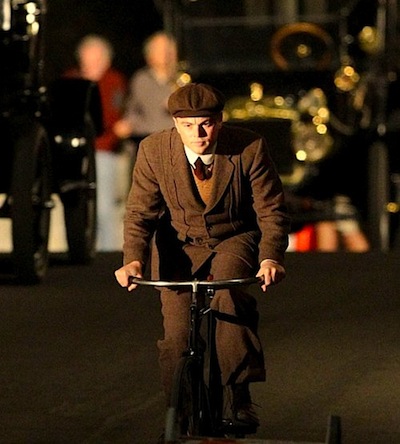
There’s a lot to like about J. Edgar in its first act. Hoover’s colorful rise is set against the struggle over communist infiltration of American society during the late teens and early ‘20s – a struggle rarely covered in cinema, as most people assume (mistakenly) that Soviet agents only first hit our shores during the 1930s. The screenplay actually begins with the bombing of Attorney General Mitchell Palmer’s home by communist/anarchist saboteurs in 1919, and we see famous figures like the young FDR and Dwight Eisenhower pour out onto the street in the aftermath – as a peppy, ambitious young Hoover arrives on a bicycle and begins piecing together clues over the bombing. In fact, if you’ve seen early set photos of DiCaprio as Hoover on a bicycle (see right), those images are likely from this opening sequence of the film – a sequence that sets the tone and mood of the film with America under a constant sate of siege (first from communist agents in the 1920s, then from criminal mobs in the 1930s, and finally from Soviet agents again from the late 1930s forward). We see Hoover and his maverick team take down Emma Goldman and a violent gang of communist-anarchist saboteurs, and Hoover begins to put the policies and procedures of modern criminal investigation in place.
The communist/anarchist saboteurs in this section of the film, incidentally, are not depicted as terribly pretty people. They’re made to look dangerous and deceptive – not as victims of a witch hunt, or martyrs. In fact, with their bomb-making factories, and attempted gamesmanship of the legal system, obvious parallels will be drawn with today’s Islamic terrorists. The message here couldn’t be more plain: a robust federal investigative force is needed to face down this threat, and ensure domestic security.
Hoover himself at this point is portrayed as dapper, fussy in his attire, mother-fixated and otherwise awkward and repressed with the ladies … but at the same time highly professional, visionary, organized, and almost Sherlock Holmes-like in his ability to draw investigative connections within a case. We learn, for example, that Hoover was one of the people responsible for the Library of Congress’ original index card system – a development that later helped Hoover conceptualize the FBI’s fingerprint database. The young Hoover is depicted as an eccentric, likeable genius, a kind of Richard Feynman of criminal investigation; if you’ve seen The Aviator, which featured DiCaprio playing Howard Hughes as a dashing eccentric, it was easy to imagine DiCaprio as Hoover here in much the same vein.
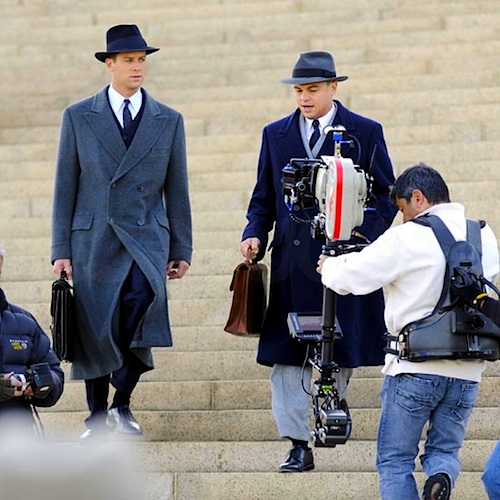
In Act Two – which is dominated by the Lindbergh baby kidnapping, and Hoover’s burgeoning relationship with his second-in-command (and eventual lover, so the story goes) Clyde Tolson – things become more complicated. The extremely complex and challenging Lindbergh case, which in its day was bigger than the O.J. trial and the Clinton impeachment all wrapped together, exposes the FBI’s legal and investigative limits – inspiring passage of the Lindbergh Law (making kidnapping a federal offense, once a kidnapper crosses state lines), the consolidation of the FBI’s fingerprint database, and the founding of the FBI’s first crime lab (quaintly enough, in the Attorney General’s private library). At the same time, Hoover himself begins to become a media figure and media manipulator, as he and his ‘G-Men’ go after high-profile criminals like John Dilinger – both in real life, and in comic strips and movies.
Here we begin to see the cracks surface in what the screenwriter takes to be Hoover’s facade. Hoover is depicted as abusing his investigative powers, using recordings of wiretapped love trysts and sordid behavior to threaten public officials; over the course of the screenplay, for example, we see Hoover threaten FDR, RFK, MLK and even Nixon at various points. Admittedly, some of these instances are depicted as acts of self-protection, or as Hoover’s effort to politely ‘hint’ to public officials that – for example, as in the case of JFK – it might not be such a great idea for a sitting President to bed down an East German communist agent; nor might it have been such a great idea, as depicted in the screenplay, for MLK to have participated in sexual trysts just prior to receiving the Nobel Prize. Be that as it may, Hoover is depicted here as ruthless, vaguely seedy, and deeply hypocritical given his own blossoming romance with Tolson – the kind of thing that would likely have destroyed his own public reputation at the time. Hoover is also depicted here as lying and exaggerating about his record, and indulging in personal vendettas.
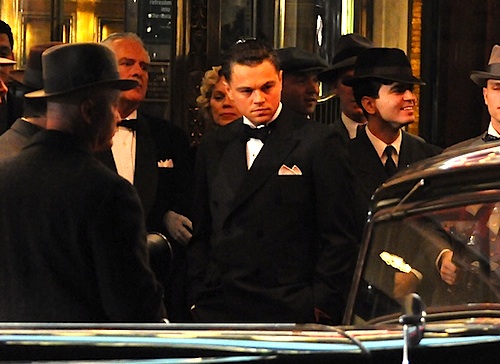
It’s really in Act Three, however, that J. Edgar’s portrait of Hoover grows truly dark, possibly to the point of caricature. Most of this has to do with Hoover’s wiretapping of MLK, and what is portrayed as Hoover’s deepening ‘paranoia’ over communist influence in government during the 1960s. Hoover’s suspicions toward those around him grow stronger, he grows colder and more callous, his lies bolder, and he’s finally depicted as little more than a creepy old man – peddling lurid audio tapes to the media, Newsweek’s Ben Bradlee in particular.
***SPOILERS AHEAD***
In a final confrontation, an elder Tolson accuses Hoover of having lied to the public for decades about his record, and we’re obviously intended to side with Tolson. Our final image of Hoover is of the FBI Director splayed out in silk pajamas, dead, surrounded by nude male statues and sex tape transcripts. Not exactly a hero’s end, as screenwriter Black (Milk) tells the story.
To say the screenplay ends on a down and cynical note would be an understatement, with Nixon’s men ransacking Hoover’s (already emptied) offices for incriminating evidence regarding Nixon himself – all while Nixon praises Hoover and his legacy in public. This, the screenplay seems to imply, is how the Machiavellian game is played in our Brave New World of government-by-secret, post-Hoover.
***END OF SPOILERS***
The screenplay thus presents what is essentially a devastating critique of Hoover the man, along with healthy doses of ambivalence about the legacy of his agency, the FBI.
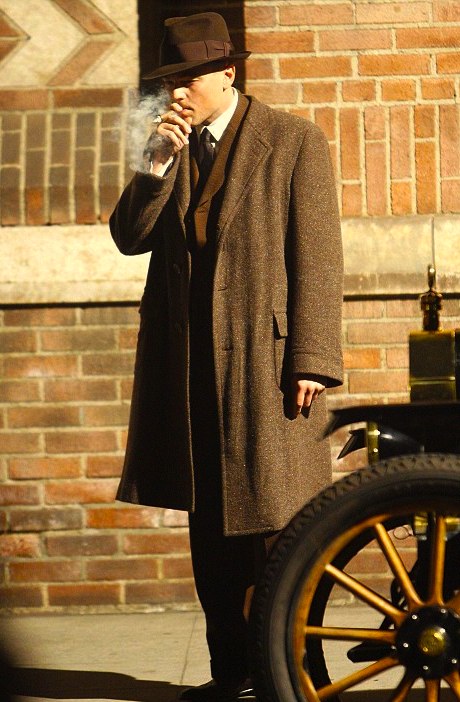
Otherwise, J. Edgar appears to continue – and, one senses, confirm – Clint Eastwood’s gradual drift from what might be termed a ‘center-right’ to ‘center-left’ perspective as a filmmaker. Mr. Eastwood, whom I’ve always admired, might quibble with that characterization, but that’s how J. Edgar at the screenplay level comes across to me – and how I strongly believe it will come across to most people come October when the film makes its inevitable award run. Eastwood himself would probably demur, and say that his leanings are more libertarian – and that Hoover’s intrusions into the private lives of public officials represented gross abuses of power, something with which I’m admittedly inclined to agree.
At the same time, J. Edgar‘s chief complaint seems to be that Hoover specifically lied for decades about his own record – and this inevitably ups the stakes in terms of the screenplay’s own accuracy. How much of this screenplay are we to believe? What were the screenwriter’s sources? Not being a Hoover scholar, I can’t vouch for the accuracy of what’s depicted – much of which I suspect will be hotly contested. I did find it odd that in the draft I read, the historical figure of Clyde Tolson – arguably the second most important person in the story after Hoover himself – was misspelled throughout as Clyde ‘Toulson,’ something that doesn’t bode well with respect to the screenwriter’s attention to detail.
In any case, the most controversial aspects of the film when it opens will likely be: 1) the depiction of Hoover’s relationship with Tolson, and; 2) Hoover’s behavior toward MLK. As for internet rumors of DiCaprio and Armie Hammer making out in the film, they’re overplayed. The screenplay I read featured exactly one (melodramatic) kiss, so don’t expect Brokeback Mountain here. The relationship between the two men is depicted as chaste – in fact, mostly they just talk about fashion together. J. Edgar Hoover is depicted in the screenplay as a major fashion plate, incidentally – with movie star good looks and an unerring sense of style. So that’s a good thing.
With all of this said, I hesitate to render a final judgement about the project as a whole – because so much depends here on how DiCaprio in particular plays the part of Hoover. A basic rule of thumb is that stars like DiCaprio don’t take on projects like this in order to make themselves look bad, or anything less than glamorous. In other words, you could do worse these days than have Leonardo DiCaprio decide to tell your life story. (You could, for example, have Paul Reubens tell your life story.)
So my sense is that for most of the film, DiCaprio/Hoover is going to come across as dashing, in the Eliot Ness vein, and only grow more corrupt as he gets older – because in the classic Hollywood equation, old = bad. Old = wrinkles. And although Hoover will take a hit from Black’s screenplay, DiCaprio’s presence will likely make up for a lot of that.
We’ll find out more, come October …
Posted on July 8th, 2011 at 11:48am.
Disappointed but not surprised and of course We’ll have to wait for the final product for final judgement. My biggest issue is of course the drift of Clint Eastwood to the left. I’ve always felt he’s been clever in his career up till the early 90’s. Since the Flag of our Fathers (although Letters from Iwo Jima is very good) debacle, I view anything he does with some skepticism.
It’s difficult to reconcile these sorts of projects with the Eastwood of, say, Firefox or Heartbreak Ridge. I continue to be surprised by the material he currently selects.
Firefox is a guilty pleasure but I’ve never warmed up to Heartbreak Ridge even though it’s a prototype Client Eastwood movie.
Personally I consider Firefox a pleasure, with no guilt involved – I actually think it’s one of his better, underrated films. Heartbreak I haven’t seen in a while, although I remember enjoying it.
What do you mean when you say that Heartbreak Ridge is “a prototype Client Eastwood movie”?
I’m going to give Eastwood benefit of the doubt, and say the film is going to reflect his libertarian leanings … especially if the communist threat is treated as credible in the early scenes.
I’ve never been a fan of the FBI, so I welcome any fair criticism directed its way. That’s a reason I enjoyed Michael Mann’s “Public Enemies” so much: The film was a pointed examination of the FBI, the reasons it was founded, and its ultimate effectiveness. I also thought Billy Crudup did a great job as Hoover.
Considering how badly federal agencies are botching matters, this could be a very important film.
Great review Jason … even though I disagree with this: “a robust federal investigative force is needed to face down this threat, and ensure domestic security.”
Thanks for the kind words, Vince, I appreciate it.
On the last point: you have to go back in time and imagine a period when all you had were local or state agencies fighting what were, in essence, multi-state criminal conspiracies. This is the problem the first act of the film depicts, leading to Hoover’s spearheading of a federal force. In essence, the idea was to pit a national force against a national threat (the Reds, the Mob, etc.). That was the basic concept Hoover endorsed and that I personally agree with.
If you helps you, however, I was highly displeased when Pres. Bush created yet another federal agency – the DHS – in the wake of 9/11, when all we really needed was to have the FBI and CIA cooperate with each other better, and share information without firewalls. I can’t for the life of me understand how creating the DHS helped that process.
First, I have to admit that I may have you at a bit of a disadvantage in that I’m sitting at my desk at work all night, and I’m feeling restless.
True, the communists did pose a huge threat, but I think it was far more subversive than something that can be swatted with the hammer of a Federal police force. As citizens, we lost what it meant to a part of a real representative republic, and let the Red slime creep through our door.
Besides, I don’t know the constitutional authority for a Federal police force. I’m reminded of this George Washington quote: “Government is not reason; it is not eloquent; it is force. Like fire, it is a dangerous servant and a fearful master.” A militarized arm of that government …? Frightening.
And I’m with you about President Bush. From my understanding, the Patriot Act was created to not only make sure those agencies cooperated, but made it illegal for them NOT to share information. Of course that didn’t get mentioned in that Michael Moore film.
You do have me at a disadvantage, then! 🙂
Hey, if you’re at your desk and catch this in time, I should be on the Lars Larson show at about 4:45pm PST:
http://www.larslarson.com/
Cool … I’ll definitely listen to that.
I just caught it out of some radio station in Virginia.
Good stuff, man. Well done.
Many thanks! I should’ve mentioned, though: you should be able to catch the stream live off Lars’ website! My mistake.
Radio’s tough, fitting everything in during a tight segment. (Also: I’m glad Lars is watching Falling Skies, although I felt silly because I’ve recorded the past two weeks of shows and haven’t even watched them yet.)
Govindini, incidentally, was on Canadian TV today talking about the Royals’ visit to LA. We’ll try to get the video on that when it’s available.
Sounds interesting. Hoover did become a BLEEP later in life, but he did leave a good foundation. Sort of like early church or group leaders, in some cases.
The thing that concerns me are the stills. No one knows how to wear a hat. A more meticulous filmmaker would have taken care of that.
It’s a good point. Some of the stills I’ve seen of DiCaprio make it look like the clothes are swallowing him up. You’ve got to wear this stuff regularly for it to look right. Hard to do that in LA, though.
Maybe I’m giving it more weight than I should, but to me, one of the central themes of Eastwood’s work is an ambivalence about traditional heroes. Going back as far as High Plains Drifter, he seems to be saying that if you want strong men to protect society outside the bounds of institutional authority, it’s going to come at a price: usually in the form of abuse and corruption. This was most powerfully captured at the close of Unforgiven where, having peeled through the layers of the western gunfighter myth, the bare essence is revealed in the form of Eastwood’s murderous Will Munney screaming drunken threats in the street while an American flag subtly waves in the background.
A biopic of Hoover would seem to be an opportunity to continue this. I just hope DiCaprio finally comes across as an adult and not as a freshman drama major trying to play one.
I think you’re quite right about this – it’s one of the touchstones of Eastwood’s career. You could even say this goes all the way back to his work in the Leone Westerns. The Man With No Name is a glamorous, but also ruthless, almost amoral figure in those films. He lives only by the professional code of the bounty hunter.
Some of these ideas did occur to me, actually, as I was reading the Hoover screenplay. But here, again, we get back to DiCaprio. How much is he capable of as an actor? Here’s who I’d have loved to see play Hoover: James Cagney, back in his prime.
Jason, I think the best contemporary choice would be Paul Giamatti.
It’s an interesting idea, but I’m not sure he’s commanding enough – nor would he bring the requisite interest an A-list performer brings. I actually think we’ve lucked out here in having DiCaprio ad glamor to the part. As I said above, you could do a lot worse, if the idea here is to make the character look good.
Was it ever confirmed that Hoover was gay? I mean, to insinuate something that may not be true is not good for some moviegoers who would actually believe he was gay. I think it should have been left out of the screenplay, but having a gay man write it, what else can you expect.
Let’s put it this way: there is circumstantial evidence that he may have been gay, although it never seems to have been ‘confirmed’ in a way that closes the case. There’s certainly no question that his relationship with Clyde Tolson was unusually close.
To be fair here, the screenplay doesn’t diverge in any radical way from the established facts about Hoover’s private life. It includes, for example, mentions of Hoover’s straight relationships with both Dorothy Lamour and Lela Rogers (Ginger’s mom); and, also, the screenplay makes abundantly clear that Hoover was too tightly wound for ‘normal’ romance, whether gay or straight. He’s basically portrayed as a fussy workaholic.
There’s only one brief scene I really objected to, but I wonder whether it will even appear in the film. In a moment of grief after his mother’s death, he puts on one of her dresses and looks at himself in the mirror, before erupting in tears. It was melodramatic, and seemed gratuitously tacked-on simply in order to put into the movie an image of Hoover in drag. But again, I wonder whether it will be kept in – or whether DiCaprio will even shoot it. It seems like, to balance things out, we should’ve also then had a scene of him in bed with Dorothy Lamour. I’m sort of imagining Salma Hayek, there. 😉 Probably DiCaprio would shoot that scene.
It’s worth mentioning here that in recently opened KGB files, we’ve learned that the Soviets were involved in a campaign to discredit Hoover by spreading the rumor of his homosexuality. Plus, people like Truman Capote apparently played along, simply because he thought the rumor would damage Hoover – not because Capote had compelling evidence on the matter.
that’s what I meant…thanks jic
I’m sorry jic. I meant that Heartbreak Ridge is the type of character that fitted Clint perfectly. Like John Wayne in a western or Humphrey Bogart as a detective or Seth Rogen as a pot smoking foul mouth slacker or Laurence Olivier in a cinematic adaption of a Shakespeare play. I think Heartbreak Ridge is a good movie it’s just that I’ve never cared for it.
I don’t think Heartbreak Ridge is a bad movie, but it is mediocre, especially by CE’s standards. A huge factor in the quality of Eastwood’s movies is the supporting cast, and the one he has here just isn’t that good.
Not even Mario Van Peebles?! 😉
I think it is a good Clint Eastwood movie..I just don’t care for it.
There was and remains a very large distance between a Communist (i.e. someone who follows Lenin’s revision of Marx) and an Anarchist, a distance that had, by 1919, been drawn with blood (Kronstadt et al).
Emma Goldman left prison after a two year sentence for opposing the draft on September 27, 1919. On October 27, she had a deportation hearing, where no evidence of any involvement in violence was established and her American nationality was revoked illegally. She was then deported with 248 others on December 21. No real time in which to be “taken down” by anyone especially as deprortation was already possible ion light of the initial judgement.
Actually, to be fair, the screenplay went into many of these details (including the distinct camps of communists and anarchists) – but I needed to compress them down for the purpose of this article.
Goldman’s advocacy of violence, as I recollect, was the issue rather than her direct participation in it. As for the legality of revoking her citizenship, my understanding is that there were ambiguities in the law that were exploited in order to make that happen.